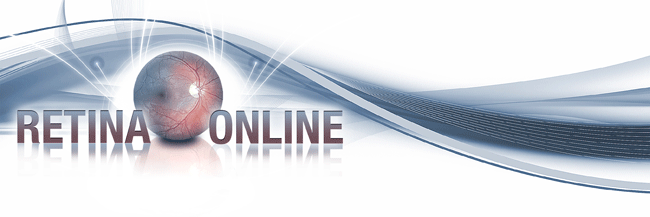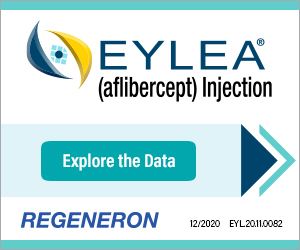Volume 18, Number 6June 2022THE LATEST PUBLISHED RESEARCH Welcome to Review of Ophthalmology's Retina Online newsletter. Each month, Medical Editor Philip Rosenfeld, MD, PhD, and our editors provide you with this timely and easily accessible report to keep you up to date on important information affecting the care of patients with vitreoretinal disease. INSIDE THIS ISSUE:
Intravitreal Aflibercept in nAMD Patients: PERSEUS-IT 24-month AnalysisPERSEUS-IT was a prospective, observational, two-year study evaluating the effectiveness and treatment patterns of intravitreal aflibercept (IVT-AFL) in patients with neovascular age-related macular degeneration in routine clinical practice in Italy. Treatment-naïve patients with nAMD receiving IVT-AFL per routine clinical practice were enrolled. The primary endpoint was mean change in visual acuity (decimal notation) from baseline to month 12 and 24. Outcomes were evaluated for the overall study population and independently for the two treatment cohorts: regular (three initial monthly doses; ≥7 injections by M12; and ≥4 injections between M12 and M24) and irregular (any other pattern). Of 813 patients enrolled, 709 were included in the full analysis set (FAS); VA assessments were available for 342 patients at M12 (FAS1Y: 140 regular and 202 irregular) and 233 patients at M24 (FAS2Y: 37 regular and 196 irregular). Researchers observed clinically relevant functional and anatomic improvements within the first 12 months of IVT-AFL treatment in routine clinical practice in patients with treatment-naïve nAMD. The gains were generally maintained across the two-year study, and the safety profile of IVT-AFL was consistent with prior studies. SOURCE: Nicolò M, Ciucci F, Nardi M, et al; PERSEUS-IT Study Investigators. PERSEUS-IT 24-month analysis: A prospective observational study to assess the effectiveness of intravitreal aflibercept in routine clinical practice in Italy in patients with neovascular age-related macular degeneration. Graefes Arch Clin Exp Ophthalmol 2022; May 5. Epub ahead of print]. Ocular Adverse Events in Patients Implanted with the PDSResearchers provide strategies for the management of key ocular adverse events that may be encountered with Genentech’s sustained-release drug system Susvimo (ranibizumab injection) in practice, and provided recommendations that may mitigate such AEs based on clinical trial experience and considerations from experts in the field. The safety evaluation was based on the Phase II Ladder and Phase III Archway trials of the PDS. As a quick review, Susvimo is a permanent, indwelling and refillable ocular drug delivery system that requires standardized procedural steps for its insertion and refill-exchange procedures, which have evolved during the PDS clinical program. Researchers described AEs that may arise after implant insertion or refill-exchange procedures, including: They recommended that surgeons using the system be made aware of potential ocular AEs and identify them early for optimal management. They wrote further of the importance of appropriate training for surgeons to ensure adherence to optimal surgical techniques and to continually refine the procedure for optimal outcomes. SOURCE: Awh CC, Barteselli G, Makadia S, et al. Management of key ocular adverse events in patients implanted with the Port Delivery System with ranibizumab. Ophthalmol Retina 2022; May 15. [Epub ahead of print].
Delayed Follow-up in nAMD Patients Treated Under Universal Health CoverageInvestigators reported the rate of delayed follow-up (DFU) visits to identify risk factors of DFU and assess the impact of DFU on outcomes in neovascular age-related macular degeneration. This retrospective study included all nAMD patients (n=1,291) treated with anti-vascular endothelial growth factor injections between January 2013 and December 2020, in two centers in Quebec, Canada. A DFU was defined as a delay of ≥4 weeks than scheduled. Visual outcomes, especially ≥15 letters loss, were reported. Here are some of the findings:
Investigators concluded that the DFU rate in nAMD patients treated under a universal health-care system was around 27 percent. They added that DFU caused significant decreases in VA and increases in IRF and SRF on OCT that didn’t recover following injections resumption despite normalization of CFT. SOURCE: Rozon JP, Hébert M, Laverdière C, et al. Delayed follow-up in patients with neovascular age-related macular degeneration treated under universal health coverage: Risk factors and visual outcomes. Retina 2022; Apr 26. [Epub ahead of print].
Vascular Anterior Surface of Type 1 MNV After Anti-VEGF TherapyResearchers evaluated whether the status of vasculature at the top of type 1 macular neovascularization could function as mediator of the observed protective effect against the development of complete retinal pigment epithelial and outer retinal atrophy (cRORA). In consecutive treatment-naïve patients, the vasculature at the anterior surface of the MNV was isolated using a slab designed to extract the most superficial vascular portion of the MNV lesion showing a choriocapillaris (CC)-like structure which researchers termed the “neo-CC.” The ratio between the neo-CC area (isolated using this custom slab) and the MNV area (isolated using the standard outer retina-CC slab) at baseline and at last follow-up was evaluated. Forty-four eyes from 44 patients were included. Here are some of the findings: Researchers reported that more extensive coverage of neo-CC was associated with a lower likelihood of development of macular atrophy in eyes receiving anti-vascular endothelial growth factor therapy. They wrote the findings suggested the protective effect of type 1 MNV may be mediated by the development of a neo-CC and may provide insights into the biological significance of MNV as a response mechanism in eyes with age-related macular degeneration. SOURCE: Corvi F, Bacci T, Corradetti G, et al. Characterisation of the vascular anterior surface of type 1 macular neovascularisation after anti-VEGF therapy. Br J Ophthalmol 2022; May 10. [Epub ahead of print]. Changes in Lens Clarity After Repeated Injections of Ranibizumab in Patients with nAMDResearchers objectively evaluated changes in lens densitometry in eyes with neovascular age-related macular degeneration treated with repeated intravitreal ranibizumab injections during a 12-month period, and compared the results with those in untreated healthy fellow eyes and healthy control eyes. In this prospective study, the 36 treated eyes and the 37 untreated fellow eyes of 38 patients with nAMD, and the 32 control eyes of 32 healthy individuals were analyzed. Lens densitometry was evaluated using the Scheimpflug imaging. All data in both groups regarding lens densitometry were recorded at baseline and 12 months. Here are some of the findings: Researchers wrote that the results objectively demonstrated early nuclear lens density changes using Scheimpflug images in nAMD eyes treated with repeated ranibizumab injections for 12 months. SOURCE: Altunel O, Irgat SG, Özcura F. Objective evaluation of changes in lens clarity after repeated injections of ranibizumab in patients with neovascular age-related macular degeneration. Graefes Arch Clin Exp Ophthalmol 2022; Apr 21. [Epub ahead of print]. Impact of Baseline Quantitative OCT Features on Response to Risuteganib for Dry AMD TreatmentInvestigators explored the effect of baseline anatomic characteristics identified on optical coherence tomography on best-corrected visual acuity response with risuteganib from the completed Phase II study in subjects with dry age-related macular degeneration. The post hoc analysis of a randomized, double-masked, placebo-controlled Phase II study included eyes with intermediate dry AMD with BCVA between 20/40 and 20/200. Patients with ocular pathology that impacted their vision or obscured the macula were excluded. Patients were randomized to receive intravitreal 1.0 mg ristuteganib or sham injection at baseline. A second 1.0 mg intravitreal injection of risuteganib was given at week 16 in the treatment arm. Two independent masked reading centers evaluated baseline anatomic characteristics on OCT to explore for features associated with a positive response to risuteganib. Treatment response was defined as a gain of ≥8 letters in BCVA from baseline to week 28 in the treatment arm compared to baseline to week 12 in the sham group. Anatomic parameters measured by retinal segmentation platforms including measures of retinal thicknesses were compared between the responders and non-responders to risuteganib. Thirty-nine patients completed the study and underwent analysis. Here are some of the findings:
Investigators wrote that baseline OCT features may help determine the likelihood of functional response to risuteganib. The use of higher order OCT feature characterization may provide an important biomarker for treatment response and could facilitate optimized clinical trial enrollment and enrichment. SOURCE: Abraham JR, Jaffe GJ, Kaiser PK, et al. Impact of baseline quantitative OCT features on response to risuteganib for the treatment of dry AMD-the importance of outer retinal integrity. Ophthalmol Retina 2022; May 12. [Epub ahead of print].
Choriocapillaris Flow Deficit and Referable DR RiskResearchers evaluated the association between the choriocapillaris flow deficit percentage and the one-year incidence of referable diabetic retinopathy (RDR) in participants with type 2 diabetes mellitus (DM). This prospective cohort study included participants with type 2 DM. The DR status was graded based on the ETDRS-7 photography. The choriocapillaris flow deficit percentage in the central 1 mm area, inner circle (1.5 to 2.5 mm), outer circle (2.5 to 5 mm) and the entire area in the macular region were measured using swept-source optical coherence tomography angiography. Logistic regression analysis was used to examine the association between baseline choriocapillaris flow deficit percentage percent and one-year incident RDR. A total of 1,222 patients (1,222 eyes, mean age: 65.1 ±7.4 years) with complete baseline and one-year follow-up data were included. Each 1-percent increase in baseline choriocapillaris flow deficit percentage was significantly associated with 1.69 times (relative risk 2.69; CI, 1.53 to 4.71; p=0.001) higher odds for development of RDR after one-year follow-up, after adjusting for other confounding factors. Researchers wrote that a greater baseline choriocapillaris flow deficit percentage detected by SS-OCTA reliably predicted higher risks of RDR in participants with type 2 DM. Thus, they added, choriocapillaris flow deficit percentage percent may act as a novel biomarker for predicting the onset and progression of DR. SOURCE: Wang W, Cheng W, Yang S, et al. Choriocapillaris flow deficit and the risk of referable diabetic retinopathy: A longitudinal SS-OCTA study. Br J Ophthalmol. 2022 May 16. [Epub ahead of print].
Diagnostic Circulating Biomarker to Detect Sight-threatening DRInvestigators determined whether circulating biomarkers could be used to prioritize people with type 2 diabetes for retinal screening to detect sight-threatening diabetic retinopathy (STDR). This multicenter, cross-sectional study collected data from October 22, 2018, to December 31, 2021 from three outpatient ophthalmology clinics in the U.K. and two centers in India. All laboratory staff were masked to the clinical diagnosis, assigned a study cohort and provided with the database of clinical data. Thirteen previously verified biomarkers were measured using enzyme-linked immunosorbent assays. Severity of DR and presence of DME were diagnosed using fundus photographs and optical coherence tomography. Weighted logistic regression and receiver operating characteristic curve analysis were performed to identify biomarkers that discriminate STDR from no DR beyond clinical parameters of age, disease duration, ethnicity (in the U.K.) and hemoglobin A1c. A total of 538 participants (mean age: 60.8 ±9.8 years; 319 men [59.3 percent]) were recruited into the study. A total of 264 participants (49.1 percent) were from India (group one: 54 [20.5 percent]; group two: 53 [20.1 percent]; group three: 52 [19.7 percent]; group four: 105 [39.8 percent]), and 274 participants (50.9 percent) were from the U.K. (group one: 50 [18.2 percent]; group two: 70 [25.5 percent]; group three: 55 [20.1 percent]; and group four: 99 [36.1 percent]). ROC analysis (no DR vs. STDR) showed that, in addition to age, disease duration, ethnicity (in the U.K.) and hemoglobin A1c, inclusion of cystatin C had near-acceptable discrimination power in both countries (area under the ROC curve: 0.779; CI, 0.700 to 0.857 in 215 patients in the U.K. with complete data; AUC: 0.696; CI, 0.602 to 0.791 in 208 patients in India with complete data). Results of this cross-sectional study suggested that serum cystatin C had good discrimination power in the U.K. and India. Investigators reported that circulating cystatin-C levels may be considered as a test to identify those who require prioritization for retinal screening for STDR. SOURCE: Gurudas S, Frudd K, Maheshwari JJ, et al. Multicenter evaluation of diagnostic circulating biomarkers to detect sight-threatening diabetic retinopathy. JAMA Ophthalmol 2022; May 5. [Epub ahead of print].
Flow and Geometrical Alterations in Retinal Microvasculature & DR OccurrenceInvestigators assessed the relationship between flow and geometric parameters in optical coherence tomography angiography images and the risk of incident diabetic retinopathy. This prospective, observational cohort study recruited patients with type 2 diabetes without DR in Guangzhou, China, followed up annually. An OCTA device (DRI-OCT Triton, Topcon) was used to obtain a variety of flow parameters in superficial capillary plexus (SCP) and deep capillary plexus (DCP): Here are some of the findings: Investigators wrote that reduced vessel density and impaired vessel geometry posed higher susceptibility for DR onset in patients with type 2 diabetes, supporting the adoption of OCTA parameters as early monitoring indicators of newly incident DR. SOURCE: Wang W, Chen Y, Kun X, et al. Flow and geometrical alterations in retinal microvasculature correlated with the occurrence of diabetic retinopathy: Evidence from a longitudinal study. Retina 2022; May 2. [Epub ahead of print]. RRD After Anti-VEGF for Retinal Diseases: Data from the Fight Retinal Blindness! RegistryScientists reported the estimated incidence, probability, risk factors and one-year outcomes of rhegmatogenous retinal detachment in eyes receiving intravitreal injections (IVT) of vascular endothelial growth factor inhibitors for various retinal conditions in routine clinical practice. The retrospective analysis used data from a prospectively designed observational outcomes registry: the Fight Retinal Blindness! Project. Included were eyes starting IVT with VEGF inhibitors (ranibizumab, aflibercept or bevacizumab) for neovascular age-related macular degeneration, diabetic macular edema or retinal vein occlusion from January 1, 2006, to December 31, 2020. All eyes that developed RRD within 90 days of an intravitreal injection were defined as RRD cases and were matched with control eyes. Estimated incidence, probability and hazard ratios of RRD were measured using Poisson regression, Kaplan-Meier survival curve and Cox-proportional hazards models. Locally weighted scatterplot smoothing curves were used to compare visual acuity between cases and matched controls. The main outcome measure was estimated incidence of RRD. Scientists identified 16,915 eyes of 13,792 patients collectively receiving 265,781 IVT injections over 14 years. Here are some of the findings:
Scientists determined that RRD was a rare complication of VEGF inhibitor IVT injections in routine clinical practice with poor visual outcomes at one year. SOURCE: Gabrielle P-H, Nguyen V, Arnould L, et al. Incidence, risk factors and outcomes of rhegmatogenous retinal detachment after intravitreal injections of anti-vascular endothelial growth factor for retinal diseases: Data from the Fight Retinal Blindness! Registry. Ophthalmol Retina 2022; May 16. [Epub ahead of print].
Novartis Gets FDA Nod of Beovu Treatment for DME The FDA approved Beovu (brolucizumab-dbll) 6 mg for the treatment of diabetic macular edema, based on year one data from the Phase III, randomized, double-masked KESTREL and KITE studies. The companies say the studies met their primary endpoint of non-inferiority in change in best-corrected visual acuity from baseline vs. aflibercept at year one. Read more. Byooviz Biosimilar Now Available in the United States Biogen and Samsung Bioepis launched Byooviz (ranibizumab-nuna), a biosimilar referencing Lucentis (ranibizumab), in the United States. Byooviz will be commercially available starting July 1 through major U.S. distributors. The list price will be $1,130 per single use vial to administer 0.5 mg via intravitreal injection, which is 40 percent lower than the current list price of Lucentis, according to the companies. The FDA approved Byooviz in September 2021 to treat neovascular age-related macular degeneration, macular edema following retinal vein occlusion, and myopic choroidal neovascularization. Read more.
Apellis Submits NDA to the FDA for Pegcetacoplan Apellis Pharmaceuticals announced the company submitted a New Drug Application to the FDA for intravitreal pegcetacoplan, an investigational, targeted C3 therapy for the treatment of geographic atrophy secondary to age-related macular degeneration. The NDA submission is based on results from the Phase III DERBY and OAKS studies at 12 and 18 months, and the Phase II FILLY study at 12 months. The FDA decision on NDA filing acceptance is expected in August 2022. Read more.
Iveric Bio Presents Post Hoc Analysis from GATHER1 Iveric Bio announced a post hoc analysis evaluating the reduction in geographic atrophy lesion growth observed in patients receiving Zimura (avacincaptad pegol) compared to patients receiving sham in the completed GATHER1 clinical trial was presented at the Retinal World Congress in Fort Lauderdale, Fla. The study analyzes the reduction in GA lesion growth, in a subset of GATHER1 patients, based on the distance of a patient’s GA lesion from the foveal center at baseline. In line with the overall results of GATHER1, a reduction of GA lesion growth in patients receiving Zimura as compared to patients receiving sham was consistently observed across all baseline distances from the foveal center, the company says. Read more.
Stealth Drug Fails to Meet Primary Endpoints in ReCLAIM-2 Trial
SOURCE: Stealth BioTherapeutics, May 2022
AGTC Announces Skyline Trial Interim Results
Luxa Bio Announces First Participant Dosed in Phase I/IIa Trial of RPESC-RPE-4W Luxa Biotechnology announced transplantation of cell product RPESC-RPE-4W into the first participant with dry age-related macular degeneration in its Phase I/IIa clinical trial. Read more. New Appointments • Neurophth Therapeutics appointed Xiaoning Guo, PhD, as chief medical officer. Read more.
SOURCE: Neurophth Therapeutics, June 2022; Applied Genetic Technologies, June 2022; Perceive Biotherapeutics, May 2022 Ophthalmologists Awarded for Using Big Data The American Academy of Ophthalmology announced recipients of the Knights Templar Eye Foundation, Pediatric Ophthalmology Fund and the H. Dunbar Hoskins Jr., MD, Center for Quality Eye Care IRIS Registry Research Fund—supporting vision research using big data. The awards honor Academy members in private practice who use the Academy’s IRIS Registry to advance patient care. View the winners.
SOURCE: American Academy of Ophthalmology, May 2022 Samsara to Initiate PMA Supplemental Study of New-generation SING IMT Samsara Vision announced that it’s initiating a PMA supplemental study to evaluate improvements in visual acuity and the safety of its SING IMT (Smaller-Incision New-Generation Implantable Miniature Telescope) in people living with late-stage AMD. Learn more.
Review of Ophthalmology's® Retina Online is published by the Review Group, a Division of Jobson Medical Information LLC (JMI), 19 Campus Boulevard, Newtown Square, PA 19073. |



